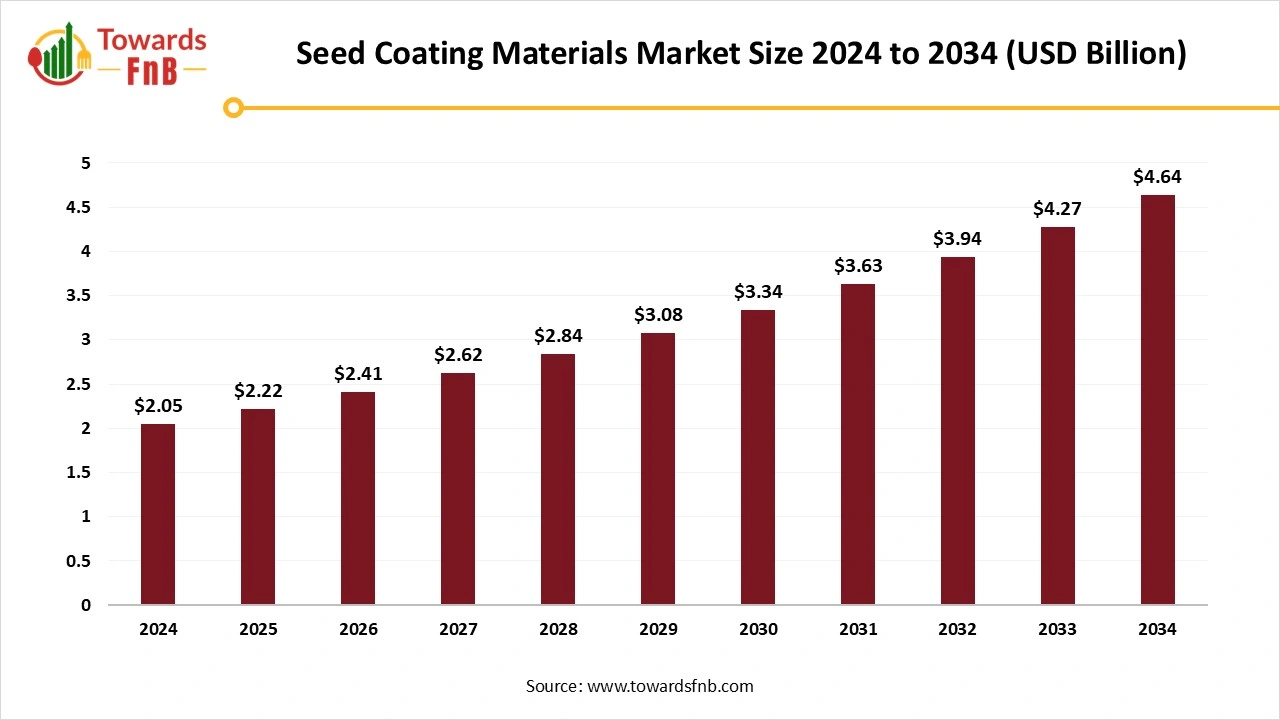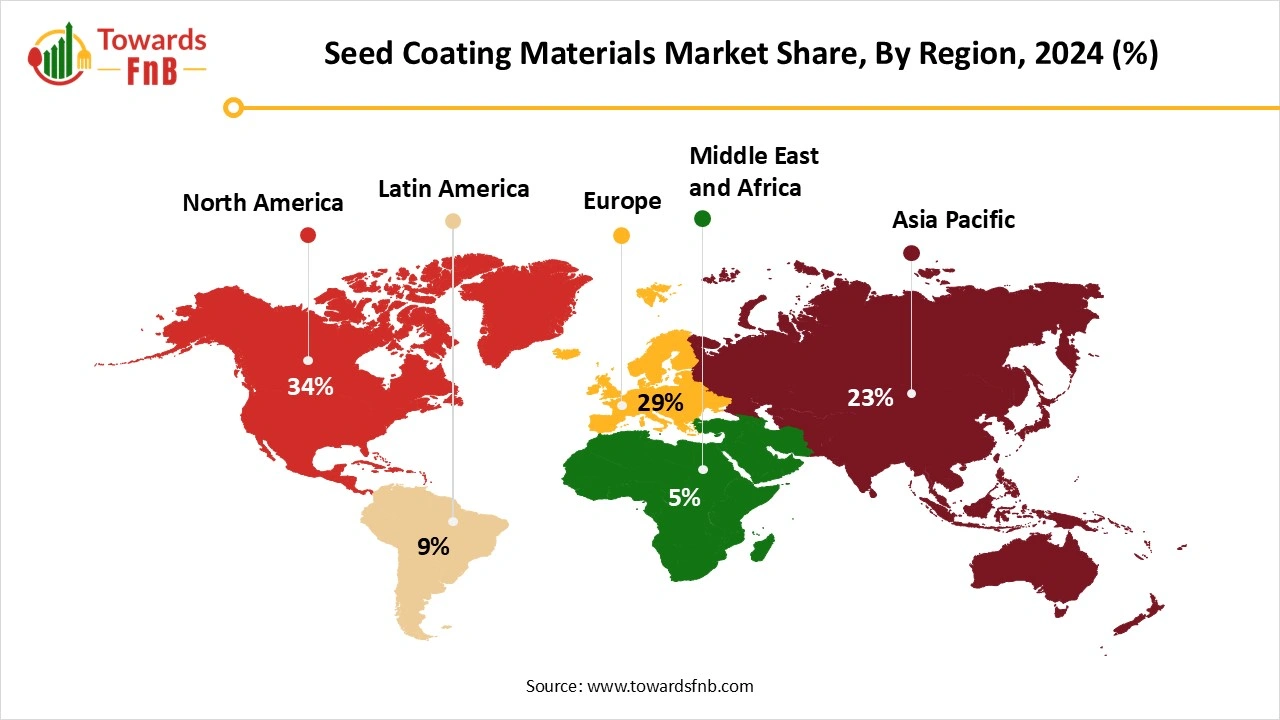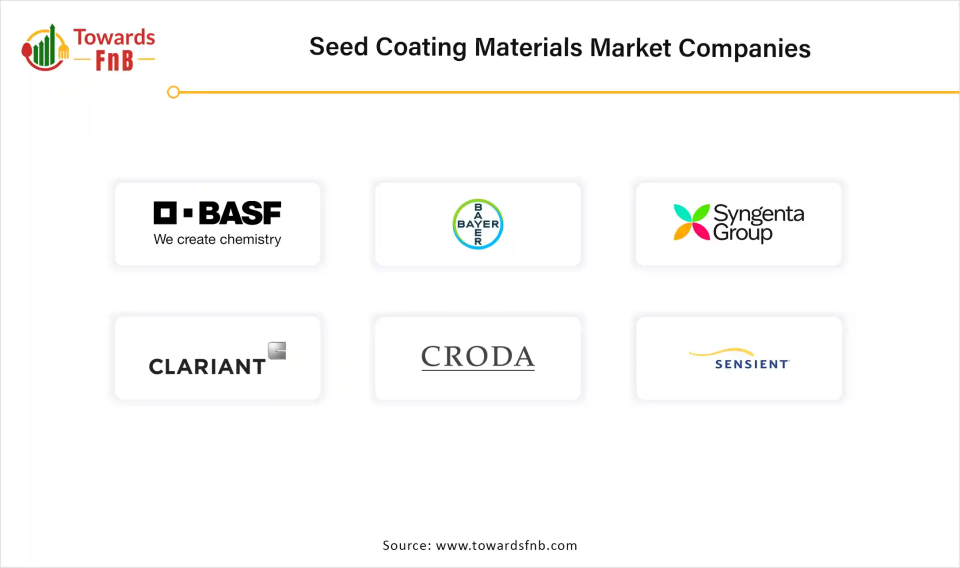December 2025
The global seed coating materials market size surpassed USD 2.05 billion in 2024 and is expected reached USD 2.22 billion in 2025. It is estimated to hit around USD 4.64 billion by 2034, growing at a CAGR of 8.5% from 2025 to 2034. The growing expertise in efficient seed handling and planting is being driven by the increased adoption of seed coating materials.

| Study Coverage | Details |
| Growth Rate from 2025 to 2034 | CAGR of 8.5% |
| Market Size in 2025 | USD 2.05 Billion |
| Market Size in 2026 | USD 2.41 Billion |
| Market Size by 2034 | USD 4.64 Billion |
| Largest Market | North America |
| Base Year | 2024 |
| Forecast Period | 2025 to 2034 |
| Regions Covered | North America, Europe, Asia-Pacific, Latin America, and Middle East & Africa |
The global seed coating materials market refers to the industry involved in the development, production, and commercialization of polymers, colorants, binders, and active ingredients applied to seeds to enhance performance, protection, and handling. Seed coatings are designed to improve germination rates, seed flowability, resistance to pests/diseases, and enable precision agriculture through accurate dosing of nutrients and pesticides.
As agriculture faces pressure from climate variability, resource constraints, and demand for higher crop yields, seed coating materials play a vital role in ensuring crop resilience, uniform emergence, and input efficiency. Innovations in biological seed coatings, nanomaterials, and sustainable polymers are shaping the future of this high-growth market.
Seed coating technologies introduce sustainable farming practices and precision agriculture methods. It is possible to directly coat seeds with essential components like fungicides, pesticides, and other seed-protecting materials without causing harm to humans through exposure to these substances. Mechanical handling of seeds is efficient and offers ease of handling due to uniformity in size and shape. There are favorable chances of crop establishment through seed treatments.
The conventional seed coating methods are associated with the use of many resources and materials, high production costs, and negative impacts on human health and the environment. The use of different components in bulk amounts or hazardous substances results in the inefficient delivery of active ingredients. The crops get damaged by adverse weather conditions and raise the challenges in protecting seedlings and plantlets.
How North America Dominated the Seed Coating Materials Market in 2024?
North America dominated the market in 2024 owing to the high demand for high-quality crops and emphasis on integrated pest management. The Farmer Seed Liaison initiative of the U.S. Department of Agriculture (USDA) plays a major role in connecting seed growers, antitrust regulators, intellectual property administrators, licensing and labeling enforcers, and other federal partners to ensure transparency in the seed marketplace. It allows an exclusive platform for seed growers, seed producers, and other people involved in the seed system to raise their voices and promote access to seeds for plant breeding and research.

What is the Regulatory Framework for Seed Health in the U.S.?
The USDA and its Agricultural Marketing Service promote fair competition and innovation in seeds and other agricultural industries. It ensures strong and resilient intellectual property rights for these innovations and competitive advantages. The U.S. Department of Interior and the Bureau of Land Management introduced the national seed strategy, which facilitates a large survey of native users of plant materials across the Eastern U.S. It also allows open access to native seed standards for ecological restoration.
Asia Pacific is expected to grow at the fastest CAGR in the seed coating materials market during the forecast period due to government support for modern agriculture and adoption of advanced farming practices. In November 2024, the Union Minister of Agriculture and Farmers’ Welfare announced the opening of the 13th National Seed Congress in Varanasi. This event united key stakeholders, policy-makers, farmers, and representatives across various public and private sectors. The Department of Agriculture and Farmers Welfare and the Government of India have made interventions in the major sectors, such as seed planning, seed production, seed infrastructure, quality control, and many others that cover the entire seed chain, from seed planting to seed supply to farmers, including the major stakeholders across the seed supply chain.
What are the Key Government Schemes and Initiatives Relevant to the Seed Coating Materials Industry in India?
The Government of India launched the SeedNet India portal, which is the national initiative to access information about quality seeds. It covers various areas of research, including seed testing and the development of seed varieties. Niti Aayog under the government of India includes responsible members working on crop husbandry, agriculture inputs, demand, and supply. With the value additions to food commodities, changing food preferences are seen. In December 2024, the Ministry of Agriculture and Farmers Welfare and the Union Cabinet approved new policy initiatives in the agriculture sector. These approved programs include the clean plant program, the digital agriculture mission, progressive expansion of the agriculture infrastructure fund scheme, the national mission on edible oils-oilseeds, and the national mission on natural farming.
How Polymers Segment Dominated the Seed Coating Materials Market in 2024?
The polymers segment dominated the market in 2024 owing to the precise and even distribution of agrochemical treatments and the efficient role as strong binding agents. They facilitate reduced dust exposure, easy identification of products, and increased shelf life of products. A wide range of polymers are required to improve plantation efficiency, seed coloring, seed binding, and many other purposes. The poly select seed polymers are suitable for film coating processes and are selected based on the coating layer on seed, seed coating, and pellet. The polymers are high-performance and high-quality solutions to enhance the potential of seed germination and crop yield.
The active ingredients (biologicals, micronutrients) segment is expected to grow at the fastest CAGR in the seed coating materials market during the forecast period, due to the alternatives to high-quality micronutrient fertilizers in the form of micronutrient seed coatings. They are attractive and practical approaches to test the effects of various elements like magnesium, iron, molybdenum, and manganese on seed germination, seed quality, and seed yield.
What made Liquid the Dominant Segment in the Seed Coating Materials Market in 2024?
The liquid segment dominated the market in 2024 owing to the enhanced adhesion of liquid coatings to seed surfaces and a uniform layer of nutrients, growth promoters, and protective agents onto the seed surfaces. They can efficiently deliver nutrients to the seeds in adverse conditions and facilitate faster germination. The liquid coatings can better suppress diseases and pests while reducing dust off harmful chemicals and exposure to the environment. They allow uniform planting and enhanced quality of seeds for improved crop yields. They are cost-effective, require less use of chemicals, and support sustainable agriculture.
The powder (in developing regions, cost-effective application) segment is expected to grow at the fastest CAGR in the seed coating materials market during the forecast period, due to the potential benefits of seed finishing powders and coating blends. Seed-finishing powders are used to cover the total seed surface area, while seed-coating blends are useful in applying seed treatments to protect seeds and seedlings from diseases and pests.
How did the Cereals & Grains Segment Held the Largest Seed Coating Materials Market Share in 2024?
The cereals & grains segment dominates the market in 2024 because they facilitate improved tolerance to stress conditions and are compatible with other seed treatments. They facilitate improved nutrient uptake and enhance early growth of seeds. There is a reduced need for the input of chemicals and increased potential for organic production. They safeguard seeds from pathogens and pests during early growth stages. There is a growing demand for environmentally friendly solutions in farming which boost the development of biodegradable seed coating materials.
The fruits & vegetables (driven by high-value produce) segment is expected to grow at the fastest CAGR in the seed coating materials market during the forecast period, due to a sustainable and circular economy. These principles are driven by using fruit and vegetables extracts derived from byproducts of food industries. They promote the optimization of resources and reduction of waste.
How Seed Protection Segment Dominated the Seed Coating Materials Market in 2024?
The seed protection segment dominated the market in 2024 owing to the advancements in seed coating technologies including film coating, seed pelleting, seed encrusting, etc. Seed coating technologies are an innovative and sustainable approach to improving seed quality and crop performance. The application of nutrients, biological agents, and protective compounds directly to seed surfaces improves crop resilience, nutrient uptake, and interaction with the soil microbiome. The various types of seed coatings, such as physical and protective coatings, nutrient and biostimulant coatings, and microbial inoculant coatings, act as barriers to protect seeds from various biotic and abiotic stress conditions. Microbial-based seed coatings are gaining traction, while advanced genetic analysis is ideal to optimize seed formulations.
The biological enhancement (biostimulants, rhizobacteria) segment is expected to grow at the fastest CAGR in the seed coating materials market during the forecast period, due to applications of biological seed coating in suppressing, controlling, and repelling insects, pathogens, and other pests that attack seedlings, seeds, or plants. The polymers act as protective layers for biological agents and help to improve the shelf-life of seeds.
What made Film Coating the Dominant Segment in the Seed Coating Materials Market in 2024?
The film coating segment dominated the market in 2024, owing to the superior sustainability of seed film coating over traditional methods like crop spraying. Seed film coating methods protect seeds maximally, and optimize seed quality, process efficiency, and crop yield.
The encrusting (used in precision planting) segment is expected to grow at the fastest CAGR in the seed coating materials market during the forecast period, due to an effective method for an efficient sowing process using mechanical planting equipment. Encrusting seeds allow the integration of products into the entrustment to protect seeds and stimulate healthy growth and development.
How did the Agrochemical Retailers Segment Dominate the Seed Coating Materials Market in 2024?
The agrochemical retailers segment dominated the market in 2024 owing to the expansion of their product portfolio by offering coated seeds beyond conventional agrochemicals to meet a wide range of needs for farmers. These retailers have exclusive opportunities to broaden their customer base by attracting more customers who are looking for sustainable and environmentally friendly crop protection and enhancement solutions.
The online & direct distribution segment is expected to grow at the fastest CAGR in the seed coating materials market during the forecast period, due to the easy preferences for automated packaging systems for coated seeds used in online distribution centers. The packaging solutions offered by online distribution channels are efficient for seed handling and distribution.
BASF SE
Bayer

By Type
By Form
By Crop Type
By Function
By Application Method
By Distribution Channel
By Region
December 2025
November 2025
September 2025
July 2025